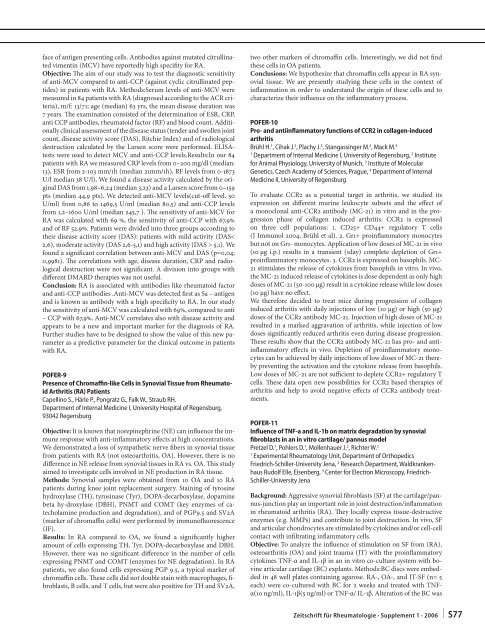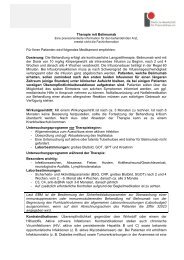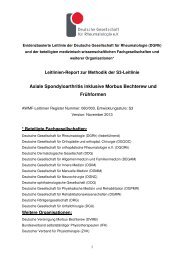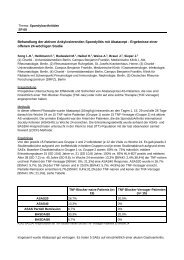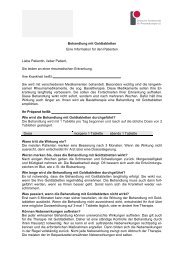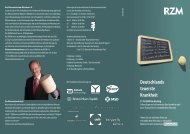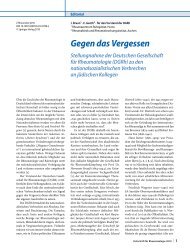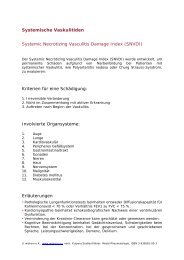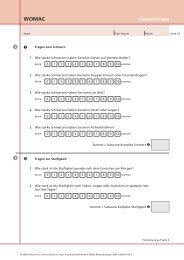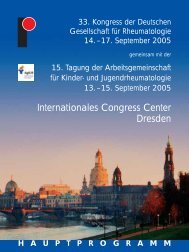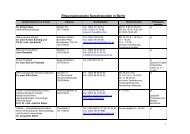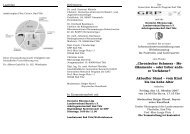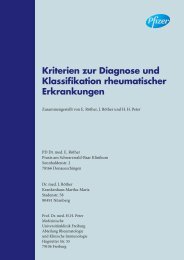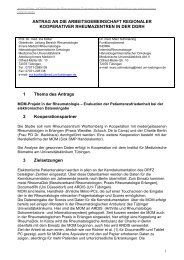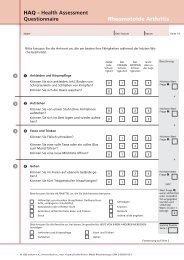Zeitschrift für Rheumatologie – Supplement 1 - Deutsche ...
Zeitschrift für Rheumatologie – Supplement 1 - Deutsche ...
Zeitschrift für Rheumatologie – Supplement 1 - Deutsche ...
Sie wollen auch ein ePaper? Erhöhen Sie die Reichweite Ihrer Titel.
YUMPU macht aus Druck-PDFs automatisch weboptimierte ePaper, die Google liebt.
face of antigen presenting cells. Antibodies against mutated citrullinated<br />
vimentin (MCV) have reportedly high specifi ty for RA.<br />
Objective: Th e aim of our study was to test the diagnostic sensitivity<br />
of anti-MCV compared to anti-CCP (against cyclic citrullinated peptides)<br />
in patients with RA. Methods:Serum levels of anti-MCV were<br />
measured in 84 patients with RA (diagnosed according to the ACR criteria),<br />
m/f: 13/71; age (median) 63 yrs, the mean disease duration was<br />
7 years. Th e examination consisted of the determination of ESR, CRP,<br />
anti CCP antibodies, rheumatoid factor (RF) and blood count. Additionally<br />
clinical assessment of the disease status (tender and swollen joint<br />
count, disease activity score (DAS), Ritchie Index) and of radiological<br />
destruction calculated by the Larsen score were performed. ELISAtests<br />
were used to detect MCV and anti-CCP levels.Results:In our 84<br />
patients with RA we measured CRP levels from 0<strong>–</strong>200 mg/dl (median:<br />
13), ESR from 2-103 mm/1h (median 21mm/1h), RF levels from 0-1873<br />
U/l median 38 U/l), We found a disease activity calculated by the original<br />
DAS from 1,98<strong>–</strong>6,24 (median 3,23) and a Larsen score from 0<strong>–</strong>159<br />
pts (median 44,9 pts). We detected anti-MCV levels(cut-off level. 50<br />
U/ml) from 0,86 to 1469,5 U/ml (median 80,5) and anti-CCP levels<br />
from 1,2<strong>–</strong>1600 U/ml (median 245,7 ). Th e sensitivity of anti-MCV for<br />
RA was calculated with 69 %, the sensitivity of anti-CCP with 67,9%<br />
and of RF 52,9%. Patients were divided into three groups according to<br />
their disease activity score (DAS): patients with mild activity (DAS<<br />
2,6), moderate activity (DAS 2,6-5,1) and high activity (DAS > 5,1). We<br />
found a signifi cant correlation between anti-MCV and DAS (p=0,04;<br />
0,9981). Th e correlations with age, disease duration, CRP and radiological<br />
destruction were not signifi cant. A division into groups with<br />
diff erent DMARD therapies was not useful.<br />
Conclusion: RA is associated with antibodies like rheumatoid factor<br />
and anti-CCP antibodies .Anti-MCV was detected fi rst as Sa <strong>–</strong> antigen<br />
and is known as antibody with a high specifi city to RA. In our study<br />
the sensitivity of anti-MCV was calculated with 69%, compared to anti<br />
<strong>–</strong> CCP with 67,9%. Anti-MCV correlates also with disease activity and<br />
appears to be a new and important marker for the diagnosis of RA.<br />
Further studies have to be designed to show the value of this new parameter<br />
as a predictive parameter for the clinical outcome in patients<br />
with RA.<br />
POFER-9<br />
Presence of Chromaffi n-like Cells in Synovial Tissue from Rheumatoid<br />
Arthritis (RA) Patients<br />
Capellino S., Härle P., Pongratz G., Falk W., Straub RH.<br />
Department of Internal Medicine I, University Hospital of Regensburg,<br />
93042 Regensburg<br />
Objective: It is known that norepinephrine (NE) can infl uence the immune<br />
response with anti-infl ammatory eff ects at high concentrations.<br />
We demonstrated a loss of sympathetic nerve fi bers in synovial tissue<br />
from patients with RA (not osteoarthritis, OA). However, there is no<br />
diff erence in NE release from synovial tissues in RA vs. OA. Th is study<br />
aimed to investigate cells involved in NE production in RA tissue.<br />
Methods: Synovial samples were obtained from 10 OA and 10 RA<br />
patients during knee joint replacement surgery. Staining of tyrosine<br />
hydroxylase (TH), tyrosinase (Tyr), DOPA-decarboxylase, dopamine<br />
beta hy-droxylase (DBH), PNMT and COMT (key enzymes of catecholamine<br />
production and degradation), and of PGP9.5 and SV2A<br />
(marker of chromaffi n cells) were performed by immunofl uorescence<br />
(IF).<br />
Results: In RA compared to OA, we found a signifi cantly higher<br />
amount of cells expressing TH, Tyr, DOPA-decarboxylase and DBH.<br />
However, there was no signifi cant diff erence in the number of cells<br />
expressing PNMT and COMT (enzymes for NE degradation). In RA<br />
patients, we also found cells expressing PGP 9.5, a typical marker of<br />
chromaffi n cells. Th ese cells did not double stain with macrophages, fi -<br />
broblasts, B cells, and T cells, but were also positive for TH and SV2A,<br />
two other markers of chromaffi n cells. Interestingly, we did not fi nd<br />
these cells in OA patients.<br />
Conclusions: We hypothesize that chromaffi n cells appear in RA synovial<br />
tissue. We are presently studying these cells in the context of<br />
infl ammation in order to understand the origin of these cells and to<br />
characterize their infl uence on the infl ammatory process.<br />
POFER-10<br />
Pro- and antiinfl ammatory functions of CCR2 in collagen-induced<br />
arthritis<br />
Brühl H. 1 , Cihak J. 2 , Plachy J. 3 , Stangassinger M. 2 , Mack M. 4<br />
1 Department of Internal Medicine I, University of Regensburg, 2 Institute<br />
for Animal Physiology, University of Munich, 3 Institute of Molecular<br />
Genetics, Czech Academy of Sciences, Prague, 4 Department of Internal<br />
Medicine II, University of Regensburg<br />
To evaluate CCR2 as a potential target in arthritis, we studied its<br />
expression on diff erent murine leukocyte subsets and the eff ect of<br />
a monoclonal anti-CCR2 antibody (MC-21) in vitro and in the progression<br />
phase of collagen induced arthritis. CCR2 is expressed<br />
on three cell populations: 1. CD25+ CD44+ regulatory T cells<br />
(J Immunol 2004, Brühl et al). 2. Gr1+ proinfl ammatory monocytes<br />
but not on Gr1- monocytes. Application of low doses of MC-21 in vivo<br />
(10 μg i.p.) results in a transient (1day) complete depletion of Gr1+<br />
proinfl ammatory monocytes. 3. CCR2 is expressed on basophils. MC-<br />
21 stimulates the release of cytokines from basophils in vitro. In vivo,<br />
the MC-21 induced release of cytokines is dose dependent as only high<br />
doses of MC-21 (50-100 μg) result in a cytokine release while low doses<br />
(10 μg) have no eff ect.<br />
We therefore decided to treat mice during progression of collagen<br />
induced arthritis with daily injections of low (10 μg) or high (50 μg)<br />
doses of the CCR2 antibody MC-21. Injection of high doses of MC-21<br />
resulted in a marked aggravation of arthritis, while injection of low<br />
doses signifi cantly reduced arthritis even during disease progression.<br />
Th ese results show that the CCR2 antibody MC-21 has pro- and antiinfl<br />
ammatory eff ects in vivo. Depletion of proinfl ammatory monocytes<br />
can be achieved by daily injections of low doses of MC-21 thereby<br />
preventing the activation and the cytokine release from basophils.<br />
Low doses of MC-21 are not suffi cient to deplete CCR2+ regulatory T<br />
cells. Th ese data open new possibilities for CCR2 based therapies of<br />
arthritis and help to avoid negative eff ects of CCR2 antibody treatments.<br />
POFER-11<br />
Infl uence of TNF-a and IL-1b on matrix degradation by synovial<br />
fi broblasts in an in vitro cartilage/ pannus model<br />
Pretzel D. 1 , Pohlers D. 1 , Mollenhauer J. 2 , Richter W. 3<br />
1 Experimental Rheumatology Unit, Department of Orthopedics<br />
Friedrich-Schiller-University Jena, 2 Research Department, Waldkrankenhaus<br />
Rudolf Elle, Eisenberg, 3 Center for Electron Microscopy, Friedrich-<br />
Schiller-University Jena<br />
Background: Aggressive synovial fi broblasts (SF) at the cartilage/pannus-junction<br />
play an important role in joint destruction/infl ammation<br />
in rheumatoid arthritis (RA). Th ey locally express tissue-destructive<br />
enzymes (e.g. MMPs) and contribute to joint destruction. In vivo, SF<br />
and articular chondrocytes are stimulated by cytokines and/or cell-cell<br />
contact with infi ltrating infl ammatory cells.<br />
Objective: To analyze the infl uence of stimulation on SF from (RA),<br />
osteoarthritis (OA) and joint trauma (JT) with the proinfl ammatory<br />
cytokines TNF-α and IL-1β in an in vitro co-culture system with bovine<br />
articular cartilage (BC) explants. Methods:BC discs were embedded<br />
in 48 well plates containing agarose. RA-, OA-, and JT-SF (n= 5<br />
each) were co-cultured with BC for 2 weeks and treated with TNFα(10<br />
ng/ml), IL-1β(5 ng/ml) or TNF-α/ IL-1β. Alteration of the BC was<br />
<strong>Zeitschrift</strong> <strong>für</strong> <strong>Rheumatologie</strong> · <strong>Supplement</strong> 1 · 2006 | S77


